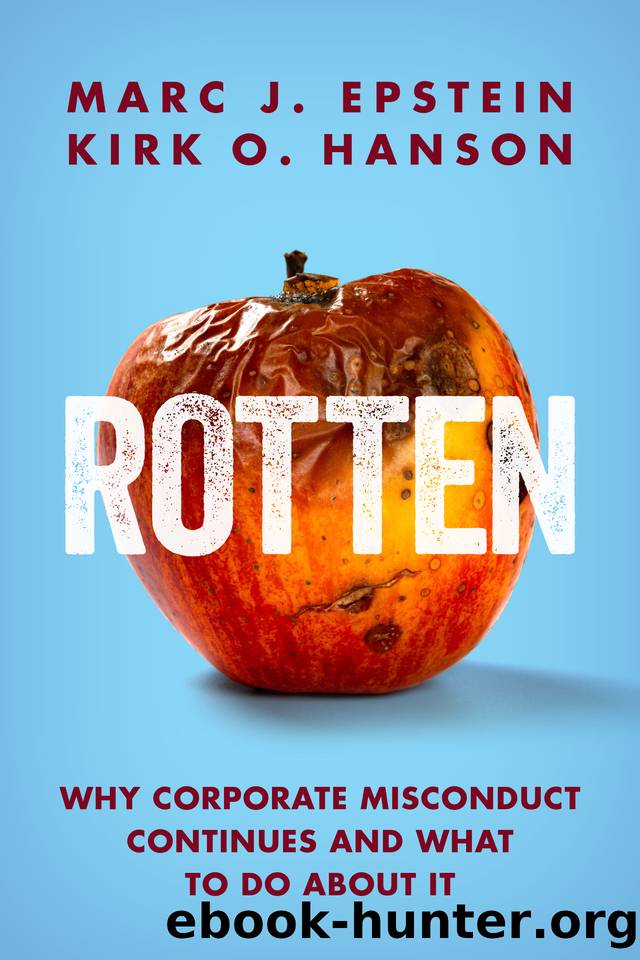Rotten: Why Corporate Misconduct Continues and What to Do about It by Hanson Kirk O. & Epstein Marc J

Author:Hanson, Kirk O. & Epstein, Marc J. [Hanson, Kirk O.]
Language: eng
Format: epub
Publisher: Lanark Press
Published: 2020-10-18T16:00:00+00:00
Why Most Corporate Efforts Have Failed to Prevent Misconduct
We believe corporate efforts to date have failed to create and sustain ethical cultures. Bad barrels of various toxicity are still the norm.
The problem is not that most companies seek to act unethically but that they instead reduce ethics to compliance. Most companies still do not consider ethics and compliance to be a priority concern. The programs suffer from the perception that the purpose is not to get caught by regulators or prosecutors, and they therefore are regarded as little more than lip service. For far too many companies, implementing some form of the twelve practices described in this chapter has become a matter of compliance, of efforts to check the boxes, but not a genuine commitment to becoming a good barrel.
In 2019, the 189 CEOs of the Business Roundtable endorsed the principle that a company serves all its stakeholders, not just its shareholders. But the disconnect between these leadersâ words and actions has created even more cynicism. Their companies have not sufficiently clarified both what that principle might mean in practice and what they are doing to implement that commitment. This fact is not lost on their own executives and employees who make their livelihoods in problematic corporate cultures.
Some companies speak clearly and credibly in ethics, but most do not. Ethics and compliance efforts remain a matter of lip service in many organizations. Very few companies truly know where their real ethics risks are and can design programs to audit those areas and clearly communicate what is expected of employees; the vast majority donât. Some boards take a genuine interest in their ethics programs; most go through the motions and nothing more.
Chapter 5 presents a program for corporations that want to take their ethical obligations seriously, describing how they can manage ethics in the organization and create good barrels for all to work in. But before we get there, we must turn our attention to the third possible source of continuing corporate misconduct: the competitive environments in which businesses operate. This is what we call the bad-orchard problem .
Download
This site does not store any files on its server. We only index and link to content provided by other sites. Please contact the content providers to delete copyright contents if any and email us, we'll remove relevant links or contents immediately.
Storytelling for dummies by Andrea Fontana(1494)
Effortless by Greg McKeown(1434)
The Practice by Seth Godin(1406)
Mastering Blockchain by Lorne Lantz(1394)
Blockchain Quick Reference by Paul Valencourt & Samanyu Chopra & Brenn Hill(1152)
Mastering Blockchain by Lorne Lantz & Daniel Cawrey(909)
The wind in the willows by Kenneth Grahame(853)
How to Lead by David M. Rubenstein(826)
The Ape in the Corner Office by Richard Conniff(792)
Handbook of Big Data Analytics by Unknown(712)
Social Media Engagement For Dummies by Aliza Sherman(711)
Taking Care of Yourself (HBR Working Parents Series) by Harvard Business Review(698)
Getting Started with Data: The first book you should read to successfully get along with data. by Menegatti Gabriel & Team Simbiose Ventures(695)
FunRetrospectives: activities and ideas for making agile retrospectives more engaging by Paulo Caroli & Tainã Caetano Coimbra(693)
Business Storytelling For Dummies by Unknown(670)
Evernote for Self Publishing: How to Write Your Book in Evernote from Start to Finish by Jose John(668)
Help! My Facebook Ads Suck-- by M. D. Cooper & Jill Cooper(654)
Genius by Choice: Your unconventional A–Z handbook to enhance your learning process by Remondino Giulia S(640)
A Leader Listens by Ajay Banga(639)
